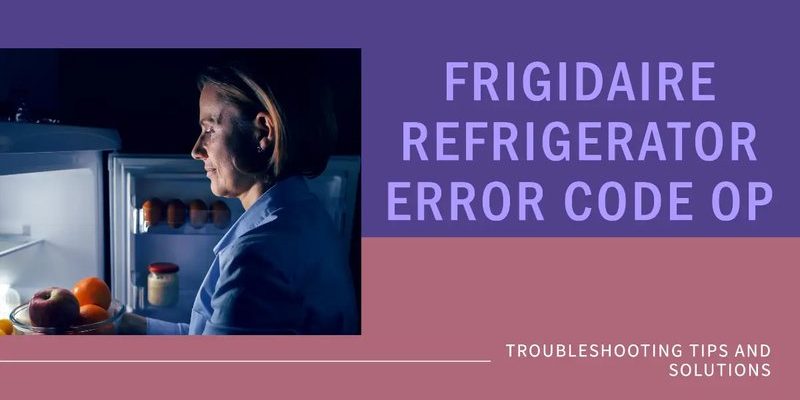
So, what exactly does this error mean for you in everyday terms? Simply put, the E3 error code generally relates to a problem with the refrigerator’s defrost system. Your fridge needs to defrost periodically to keep the cold air circulating well, much like how you might need a quick break to keep working efficiently throughout the day. If something in this defrosting process goes awry, your fridge can’t function at its best, leading to the dreaded E3 error message. Let’s dive into the nitty-gritty of what’s causing this error and how you can tackle it without breaking a sweat.
Understanding the Defrost System
To figure out what might be causing the E3 error code, let’s first take a closer look at how the defrost system in your Frigidaire refrigerator works. Picture the defrost system as the refrigerator’s maintenance crew, responsible for keeping everything clean and in order. This system periodically melts away any frost that builds up on the evaporator coils. Why is this important? Well, when frost builds up, it blocks airflow, making it hard for the fridge to stay cool.
Inside this defrost system are several key players: the defrost heater, defrost timer, and defrost thermostat. Think of the defrost heater as a cozy electric blanket that wraps around the coils, melting any accumulated frost. The defrost timer acts like a schedule maker, ensuring defrost cycles occur at regular intervals. Lastly, the defrost thermostat is like a diligent watchdog, making sure the heater only kicks on when necessary and turns off when it’s warm enough. If any of these components fail, the defrost process can be disrupted, often leading to that pesky E3 error.
Now, what can you do if one of these components isn’t pulling its weight? A good starting point is to visually inspect the defrost heater and thermostat. These components will often show signs of wear, like burnt spots or disconnected wires. The defrost timer, however, can be a bit trickier, as its issues are usually internal. If you’re comfortable doing so, you can manually advance the timer to test if it’s functioning properly. If any part of this defrost team seems faulty, replacing it can help clear up the error and get your fridge back to its chill self.
Common Culprits Behind Error Code E3
You’re probably wondering, “What usually causes these parts to fail?” One common issue is simply aging — over time, components wear out just like an old pair of sneakers. The defrost heater might burn out after many cycles of heating and cooling, similar to how a light bulb eventually stops shining. Another possible culprit is electrical issues. If there’s been a power surge, it might have fried one of the defrost components, much like how a sudden jolt of electricity can knock out a home appliance.
Sometimes, the problem might not be with the defrost system at all, but rather with the wiring that connects it all. Imagine these wires as the arteries carrying power to the fridge’s vital organs. If a wire is loose or damaged, it can lead to erratic defrost behavior and, you guessed it, trigger that E3 code. Rats, pests, or even general wear and tear can be responsible for wiring issues, requiring a careful inspection to pinpoint the problem.
After identifying the issue, the next step is to fix it. If it’s a faulty component, replacement is often the best route. For wiring problems, securing or replacing damaged wires might be the solution. By addressing the root cause of these common issues, you can prevent the E3 error from rearing its ugly head again in the future.
Preventing Future E3 Errors
Once you’ve tackled the error code, it’s time to think about prevention to keep your fridge running smoothly long-term. Regular maintenance is key — much like how regular exercise keeps our bodies in top shape. Start by ensuring your refrigerator is properly maintained according to the manufacturer’s guidelines. This involves cleaning the coils, checking door seals for leaks, and ensuring nothing is obstructing airflow.
Additionally, ensure your fridge is level. An uneven fridge can cause components to work harder than necessary, leading to premature wear and tear. It’s a bit like trying to walk uphill all the time — it gets exhausting! Regularly check that the appliance is balanced and adjust the leveling legs if needed.
By staying proactive, you can keep the fridge’s defrost system and other components in tip-top shape, minimizing the chances of seeing that pesky E3 error again. However, if the problem persists or if you’re ever unsure about a repair, it’s always wise to consult with a professional technician who can provide expert advice and service.
When to Call in a Professional
At the end of the day, some refrigerator issues can be a bit like trying to solve a mysterious puzzle. While we’ve covered the basics, there are times when getting some expert help is your best bet. If you’ve tried the above steps and the error code still won’t budge, or if you feel uncomfortable handling electrical components, it’s time to bring in the pros.
Professional technicians can perform in-depth diagnostics with specialized tools, much like a detective cracking a difficult case. They can verify whether you’re dealing with a hidden problem or if there’s something more complex at play behind the scenes.
In the world of refrigerators, safety always comes first. So, don’t hesitate to call a qualified technician to ensure your fridge gets the attention it needs — keeping your food fresh and your mind at ease. With a little patience and the right help, you’ll have your Frigidaire refrigerator back in working order, keeping things cool and collected once again.
